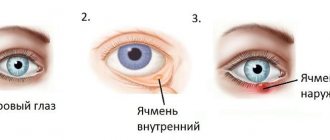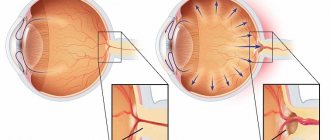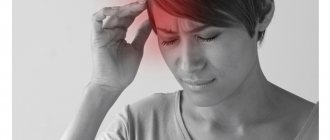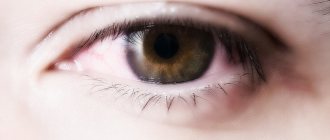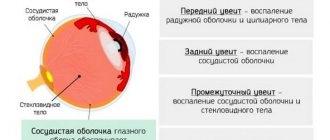Symptoms
In addition to the pain in the eye sockets, accompanying symptoms appear. They depend on the pathological process and the nature of the disease. Diagnosis is difficult. Most ophthalmic diseases have symptoms such as pain and redness. Associated symptoms:
- swelling;
- nervousness;
- decreased visual acuity;
- redness;
- sensation of a foreign object in the eyes;
- increased and uncontrolled lacrimation;
- itching;
- burning.
The pain has a different character. Despite this, such symptoms should not be ignored. At the first manifestations, you should consult an ophthalmologist. Especially if the pain does not go away within two days and is persistent. In most cases, such symptoms indicate the presence of serious illnesses.
Treatment methods for this symptom
Symptomatic drug treatment for pain in the eye muscles is not prescribed, since such drugs do not exist.
Although in case of severe pain, you can take a general pain reliever: Nurofen, Tempalgin, Ketonal .
On topic: Groin muscles in girls
In this case, eliminating the pain syndrome will be more effective with the help of regular therapeutic exercises , which develops and strengthens the muscles, preventing the occurrence of pain.
Gymnastics to train muscles and relieve pain
Gymnastics for the eyes is of a general strengthening nature and can be performed at any convenient time : at work, at home and even in transport (although the latter option is the least preferable).
Such secondary measures have a general tonic effect on the body’s circulatory system, as a result of which the organs of vision are sufficiently supplied with oxygen and the muscles become less susceptible to degenerative processes.
A set of exercises for the eyes includes gymnastics to strengthen external and internal muscles. To strengthen the external (external) muscles includes the following actions:
- It is necessary to take a sitting position, keeping your back straight. The eyes move from the ceiling to the floor and back 10-15 times.
- In the same position, the eyes move left and right 10-15 times.
- Next, you need to make five rotational movements with your eyes clockwise and counterclockwise.
- At the end of the workout, you need to blink intensely for 30 seconds.
To train the internal muscles, you need to prepare a circle with a diameter of about 5 millimeters, made of dark paper and glue it to the window.
Having positioned yourself by the window so that there is 30 centimeters from the eyes to the circle, you need to concentrate your gaze first on it, and then transfer your vision to any medium-sized object outside the window.
It could be a car, a tree, or the window of the house opposite. The main thing is that the object is motionless. On the circle and on another object, the gaze must be held for 15-20 seconds; in one approach, 5-6 such cycles must be completed.
Folk remedies
Along with gymnastics, you can use traditional medicine.
But before this, you need to make sure that you are not allergic to the components included in the formulation, and before treatment, it is advisable to consult an ophthalmologist .
The following remedies will help with this eye disease:
- Cilantro compress. Fresh herbs must be chopped (one tablespoon of such herb pulp is enough). Then the cilantro is mixed with a tablespoon of aloe juice and the same amount of honey. The finished mass is applied to the area around the eyes (but in no case on the eyelids) and left for 15 minutes, after which it is washed off with cool running water.
- A mixture of chicory, horsetail, rose petals, marshmallow and dill seeds (all ingredients are mixed in equal quantities to make a teaspoon of the product) is poured with a glass of boiling water. The cooled liquid should be filtered and instilled three times a day, two drops into each eye.
- Half a glass of fresh cucumber peel is filled with 100 grams of cool boiled water , after which a pinch of salt is added . The liquid must be thoroughly mixed and left for 10-15 minutes so that the peel releases juice. Cotton swabs are soaked in the prepared solution and placed on the eyes for half an hour.
People who eat these foods regularly and in sufficient quantities do not face the problem of eye pain.
General recommendations
Muscle pain in the neck can be avoided if you follow these tips:
- You should not read lying down : contrary to popular belief, this does not lead to damage to vision as such. But due to the unnatural position of the muscles, they begin to stretch, which becomes the cause of their pain and an indirect cause of refractive error over time.
- When performing delicate work that requires full concentration of vision, it is necessary to provide yourself with good lighting .
- If your eyes begin to get tired during the first two hours of working at the computer, it is recommended to use special computer glasses . If you work at a computer throughout the working day, you need to take breaks every hour and a half and do eye exercises.
- All infectious ophthalmological diseases must be treated in a timely manner to prevent complications affecting the functioning of the eye muscles.
Eyeball hurts when pressed
If the eye hurts when pressed, this may be a sign of increased intraocular pressure, the presence of neoplasms, the development of glaucoma, or post-traumatic syndrome. Often this pain is characteristic of tired eyes. If it hurts to press and it radiates inwards, then this happens when sand or other small particles get into the eye. Such signs occur when blood vessels are damaged. Main reasons:
- Excessive strain on the eyes. This leads to fatigue and stress. Such symptoms are often encountered by people who constantly work on computers. This leads to the development of dry eye syndrome. It is accompanied by discomfort and pain. To eliminate this syndrome, you need to use moisturizing drops and give your eyes a chance to rest.
- Chronic glaucoma. The disease is accompanied by the fact that the damaged eye hurts inside, especially when blinking or pressing. In poor lighting, a person suffers from decreased visual acuity.
- Presence of tumors. With the development of neoplasms, one of the signs is this type of pain.
Symptoms may be in one eye or both. Glaucoma usually affects one eye. Diagnosis will require a thorough examination.
Optic neuritis
The pathology is an inflammation of the second cranial nerve. The general clinical picture is similar to the manifestation of papilloedema, but without the characteristic increase in intracranial pressure. The most common cause is pathology of the central nervous system (selective damage to the myelin sheath), less often - sinusitis, inflammation of the orbital contents.
Pain inside the eye is the main symptom of the pathology, intensifying with its movement. Additionally, the patient complains of changes in the perception of shades, deterioration of vision, and the appearance of pointless images before the eyes.
Diagnosis of the disease is quite difficult; instrumental research methods cannot always reveal characteristic changes in the fundus. The task is to determine the presence of multiple sclerosis, which is a provoking factor of the disease.
The eyeball hurts and radiates to the head
When there is pain inside the eyes and radiates to the head, a person is in a painful state. To reduce such symptoms, you have to look for a comfortable position. In addition, dizziness, nausea, and loss of coordination may occur. Such symptoms may indicate hypertension, migraine, or increased intraocular pressure.
With hypertension, additional black spots may appear before the eyes.
Glaucoma is accompanied by discomfort when moving. It is difficult for the patient to focus vision on a specific object. These symptoms may be accompanied by nausea. The occurrence of intracranial pressure causes pain in the forehead and eyes. The patient often suffers from insomnia.
The presence of migraine is accompanied by sensitivity to light. A person reacts painfully to loud sounds and music. Increased irritability and nervousness.
Often such symptoms occur due to disorders of the vascular system. The pain syndrome may intensify with a sudden movement of the head. Among serious diseases, ischemic stroke should be highlighted. Its occurrence is accompanied by severe pain and blurred vision.
Causes of pain and nausea
Brain concussion
Occurs as a result of a strong blow to the head on a hard object or during a fall. Inside the skull, the pressure of the cerebrospinal fluid changes, and the brain hits the bones of the skull. After the injury, dizziness begins, there is a lot of pressure on the eyes, nausea, and sometimes an attack of vomiting occurs. Memory and speech disorders, loss of coordination, and increased drowsiness may occur. The child develops prolonged crying or moodiness and refuses to eat.
Vegetovascular dystonia
The pathology is characterized by disruption of the autonomic nervous system. The disease appears as a result of bad habits, regular stress, psycho-emotional stress, dysfunction of the gastrointestinal tract, cardiovascular or hormonal systems. The disease is often accompanied by an increase or decrease in blood pressure. Pathology manifests itself as follows:
Fatigue and weakness can be symptoms of a disease such as vegetative-vascular dystonia.
- weakness, fatigue;
- headache and dizziness;
- presses in the eye area;
- mild nausea;
- sweating;
- hot flashes or chills;
- coldness in hands and feet;
- heart rhythm disturbance;
- feeling of lack of air;
- bowel disorder.
Neuropsychic stress
The condition occurs as a result of prolonged stress, an acute conflict situation, serious illness or loss of a loved one, due to financial or career problems. Tension can also be caused by prolonged mental work, labor that requires concentration and vision. During stress, an excessive release of hormones into the blood occurs, which contributes to the dilation of blood vessels and an increase in the load on the heart. When visual stress occurs, asthenopia occurs due to overstrain of the extraocular muscles. Symptoms:
- darkens in the eyes;
- headache and dizziness;
- slightly nauseous;
- eyes become red;
- absent-mindedness occurs;
- a whitish veil appears or double vision appears;
- makes you sleepy.
Brain tumors
Traumatic brain injury can cause tumors to form, causing a person to feel headaches and nausea.
Pathology includes formations that arise inside the cranium, covering all structures of the brain - nerves, endocrine glands, blood vessels, membranes. Such tumors include pineocytoma, medulloblastoma, astrocytoma, ependymoma, and meningioma. Neoplasms are formed due to bad habits, traumatic brain injuries, contact with pesticides, exposure to an area with increased background radiation, and also as metastases if there is already a focus of cancer in the body. With this disease, intracranial pressure increases and the following symptoms occur:
- nausea and vomiting;
- headache and dizziness;
- violation of movement coordination;
- darkening of the eyes;
- convulsions;
- pain in the eyes and protrusion of the eyeball;
- extraneous noise in the ears;
- decreased vision;
- speech disorder.
Sinusitis - inflammation of the mucous membrane of the paranasal sinuses
Depending on the location of the inflammatory process, the disease is divided into sinusitis, ethmoiditis, and frontal sinusitis. It occurs mainly due to the entry of pathogenic microorganisms into the nasal sinuses - staphylococcus, streptococcus, pneumococcus, viruses, fungi. Other causes include traumatic injuries, allergic reactions, and abuse of nasal medications. Symptoms:
When bacteria enter the nasal sinuses, mucopurulent discharge appears, which may be accompanied by fever.
- temperature increase;
- mucopurulent discharge from the nasal passages;
- nasal congestion;
- nasal voice;
- facial pain;
- headache;
- pressing soreness in the eyes;
- lack of appetite;
- weakness, fatigue;
- sleep disturbance.
Poisoning
If poisons get inside, the victim should be immediately given first aid and taken to a medical facility, since the condition is life-threatening.
Poisonous agents can be inhaled. These are paint and varnish products, volatile pesticides, and increased accumulation of exhaust gases in the air. Poisonous substances can also be accidentally ingested. These include acids, alkalis, fertilizers, and insect poisons. Depending on the etiology of poisoning, the signs differ as follows:
As a result of poisoning, nausea and a gag reflex appear, which entails dizziness.
- Volatile poisons: severe dizziness, headache;
- eye pressure and pain;
- nausea or vomiting;
- drowsiness;
- increased thirst.
- vomiting with blood;
The eyeball is sore and red
The eyes are a unique organ in the human body. Because of their sensitivity, they are equipped with protection – for centuries. But it is not always possible to protect the mucous membrane from small particles. If pain is felt inside, then you need to examine the eye and check for the presence of foreign substances in it. The ingress of sand and debris is accompanied by severe pain and redness. Uncontrollable tearing also occurs. This is a natural protective function that helps small particles come out of the eyes on their own.
Vascular diseases are also accompanied by such symptoms. Capillaries in the sclera often burst, causing redness. This may be affected by exposure to strong winds and cold. When local blood flow is disrupted, the following symptoms occur. Excessive strain on the eyes may cause dryness.
When the eye muscles suffer from overstrain, this causes pain. Long-term reading, working at the computer, and prolonged watching of TV negatively affect the condition of the visual organs, especially in low light conditions. This leads to spasm. If you do not begin to eliminate such symptoms in time, deformation of the eyeball may occur. The pain syndrome may intensify when blinking.
Allergic conjunctivitis can also cause red and painful eyes. In addition, severe itching and uncontrollable lacrimation occur. Inflammation of the conjunctiva may occur. Diagnosis will require an examination by an ophthalmologist and an allergist. Antihistamines and antiallergic drops for topical use will help eliminate such symptoms.
Other reasons
Painful sensations when moving the eyeball may not be a consequence of ophthalmic diseases and may manifest themselves due to the influence of external factors. Common causes of unpleasant symptoms are:
- Migraine. Periodic attacks of pulsating headaches radiating to the temples and eyes. Most often, pain symptoms occur on one side of the head; an attack can last from 2 hours to several days. Associated symptoms are: intolerance to bright light, loud sounds, smells, as well as nausea and vomiting.
- Visual fatigue. Develops as a result of spending a long time at a PC, working with small details, as well as activities that require concentration. Visual strain can lead to the fact that it becomes painful for a person to move the eyes, heaviness, sand in the eye socket and redness are felt.
- Contact lenses. Prolonged wear, incorrectly selected optics, and poor hygiene can lead to irritation of the mucous membranes, tension in the eye muscles, and pain when moving the eyeballs.
- Damage to the visual apparatus, penetration of a foreign object into the eye socket. Even a small speck that gets into the eye cavity can cause intense tearing, redness and inflammation of the mucous membrane. The pain usually intensifies when moving the eyeballs from side to side.
In addition, pain in the organs of vision can become a manifestation of other diseases: influenza, ARVI, neuroses, vegetative-vascular dystonia, hypertension, benign neoplasms, cancer, vascular diseases, infections (tonsillitis, sinusitis, etc.), caries, lichen.
Diagnostics
Timely diagnosis is very important. A qualified specialist will be able to determine the cause of such symptoms and prescribe the necessary treatment. Therefore, if symptoms develop, you should seek help from a specialist. It is worth considering that pain may indicate a serious illness.
At the appointment, the doctor performs a visual examination. You should also study the patient's medical history and listen to his complaints. If necessary, the doctor uses special equipment for in-depth diagnostics. It consists of the following examinations:
- ophthalmoscopy;
- determination of visual fields;
- Ultrasound;
- MRI and CT of the brain;
- biomicroscopy.
After the examination results, the doctor can make a diagnosis and prescribe drug therapy. Self-medication is strictly not recommended. This can lead to the development of severe complications. Examination by other specialized specialists may be necessary.
What does pain in the forehead mean?
Not only eye diseases are to blame for the fact that most people suffer from severe headaches (about 60%), the symptoms may be due to the development of pathology in the blood vessels of the brain. These include pallor, weakened general condition, attacks of nausea and vomiting. If the disease is viral in nature, then treatment should be carried out in combination. Otherwise, excessive use of antibiotics will lead to increased pain.
If pain is felt in the right side of the forehead, then this usually indicates the following cases:
- Osteochondrosis of the cervical spine.
- Development of stroke.
- The presence of neoplasms in the body.
- Getting injured.
- Costen's syndrome.
- Tonsillitis.
- Paroxysmal hemicrania of chronic form.
What can cause pain in the eyeballs and head on the left side of the forehead?
In this case, everything may indicate diseases that are widespread in many countries of the world:
- The appearance of tumors.
- Osteochondrosis.
- Diseases of an infectious nature.
- Migraine.
- Cold.
- Uneven distribution of muscle load.
- Sustaining head and neck injuries.
- Stroke.
- Meteosensitivity.
Treatment
Pain syndrome is not a disease. This is a sign of certain pathological processes. If symptoms occur after prolonged exercise, then walking in the fresh air and getting enough sleep will be enough. If the pain occurs for unknown reasons, then a doctor will help determine them.
Ophthalmological diseases require the use of moisturizing, antibacterial, antiviral drugs. For severe bacterial infections, the doctor prescribes antibiotics and vitamin complexes. Glaucoma will require constant monitoring of intraocular pressure.
Any form of conjunctivitis requires treatment with solutions based on chloramphenicol and sodium sulfacyl. Treatment must be comprehensive. The doctor prescribes a treatment regimen individually for each patient. When using medications, the patient may experience burning, redness, and itching of the mucous membrane. Sometimes it may seem that the eye is aching from pain. In this case, you must inform your doctor. You may need to change medications.
Prevention
The main rule of prevention is timely diagnosis of diseases and drug therapy. It is worth noting that every person should be examined by an ophthalmologist once a year. If the cause of the pain is hidden in the development of other diseases, then an examination by specialized specialists will be required.
The development of dry eye syndrome occurs as a result of excessive stress and fatigue. Dryness provokes pain, burning, and itching. To prevent and eliminate such symptoms, you need to give your eyes a rest. Adequate and healthy sleep is important.
When working at a computer for a long time, you need to take breaks to rest. It is useful to do eye exercises at this time. To prevent dryness, you should use moisturizing drops. Instillations are done with strict adherence to hygiene rules. It is important not to touch the tip of the bottle to the mucous membrane. This may lead to infection. It is not recommended to take ophthalmic medications on your own. Before use, you should consult a specialist.
